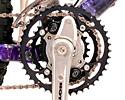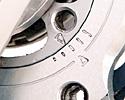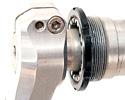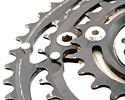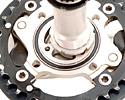
Recently on Cyclingnews.com |
On test: Rotor RSX4 MTB, February 7, 2006
Go-faster rings
The intricacies of Rotor's crank mechanism are initially daunting, but in the field and on the trail, it really does seem to deliver on the claims, as James Huang finds.

|
In a world of superlight carbon fiber cranks, a Rotor crankset sticks out like a sore thumb with its somewhat awkward-looking assortment of additional hardware and appendages. Rotor has replaced their old configuration with the new RSX4, which consists of a semi-integrated two-piece crank and bottom bracket arrangement with a splined spindle. The new setup, however, still does not use the dual-outboard bearing construction that people have now gotten used to and the new splined spindle isn't much larger in diameter than the old square tapered one. At 1310g (2.89 lbs), our RSX4 MTB steel test crankset is also not only over a full pound heavier than a current-generation XTR crankset, but with a suggested retail price of US$729, it's also nearly US$270 more expensive. Oh, right, plus it's kind of funny looking. So… tell me again why someone should buy these?
The concept
Well, clearly Rotor would have gone under years ago if there were no performance benefits to this thing and Rotor makes some rather heady claims, such as a 16% increase in power output, a 15% reduction in lactic acid production, and a 5% reduction in heart rate as compared to a standard crankset. These benefits are allegedly the result of their unique system which constantly varies the angle of the crankarms relative to each other to eliminate the dead spot from your pedal stroke.
The system looks quite complicated, but it's really reasonably simple in concept. Both crankarms rotate about the center of the bottom bracket shell as usual, but the center of rotation of the chainrings is offset slightly forward. A pair of stout, roller bearing-equipped links drives the chainrings as you push down with either crankarm, and the eccentric nature of the system varies the mechanical leverage ratio depending on the position of the crankarms and simultaneously alters the crankarm angles a bit throughout the rotation.
What's the net effect? As you push down with one leg on the downstroke, the Rotor system accelerates the other leg through the backstroke. As a result, when one leg is sitting dead in the water at 6 o'clock, the other leg is positioned at about 1 o'clock which immediately puts you back on the power right when there normally wouldn't be any. That all sounds good on paper, but how is it in reality?
Out of the box
Overall construction quality of the Rotor is superb. Parts are intricately and precisely machined and the alignment of all of the various bits is spot-on. Installation of the Rotor was straightforward, but not entirely intuitive. With the number of notices printed on the box and elsewhere, Rotor practically begs you to read the installation instructions first, and for good reason. I don't care if you whittled your riding lawnmower out of knotty pine with a pair of tweezers while blindfolded and hogtied; as a seasoned mechanic with over ten years under his belt, I don't think even I would have done this properly without reading the manual, which, by the way, is very clearly written.
Simply getting the cranks physically on the bike is one thing, but the tricky part is setting the relative angle of the crankarms. This adjustment is critical as is the manner in which that position is locked in place as it turns out that minor changes result in a very tangible difference. Varying the setting adjusts just how far ahead of top dead center the crankarm is when the other is down at 6 o'clock and Rotor conveniently provides some very helpful guidelines based on your pedaling style and positioning. I tried several positions but eventually settled on the default 'middle' position.
For those of you who are wondering, Rotor also has a singlespeed configuration available which consists of the same 34T ring as on the triple setup but with a matching CNC machined outer chainguard and dummy inner chainring without teeth to protect the main bearing. Both configurations were tested here.
Out on the trail
My first few times out on these things were, to be completely honest, pretty odd. Having spent my entire cycling life with my pedals exactly 180° out of phase, it was rather unsettling to experience otherwise. Once I got over the initial weirdness, though, Rotor's claims start to make some sense. The most obvious effect of the system is that it feels as if you always have your foot buried on the gas. Without a dead spot to disrupt your power output, there is a constant transmission of torque to the rear wheel. In addition, the Rotor's cam arrangement effectively increases the leverage ratio when you're pushing down. This combination of effects had me consistently upshifting one or two gears higher than usual, but without any increased effort. Shift quality up front was admirable, particularly given that the offset arrangement sets the rings a little further away from the front derailleur cage than usual. And speaking of chainrings, our test crank came with a 22/34/44T chainring arrangement, but the added leverage on the downstroke had me wishing that I had requested a 46T. In spite of the small-diameter bottom bracket spindle and relatively shallow-profile CNC arm construction, the crankset felt plenty stiff.
Singlespeeding on the Rotor provided an interesting testing ground as few other applications require such an enormous range of cadences. It was difficult at first to produce a smooth high-cadence as your leg speed isn't the same going down as it is coming up. Spinning on the flats and downhills proved to be an exercise in retraining muscle memory but it was manageable in time. In those inevitable singlespeed situations where you find yourself hopelessly overgeared on a climb, though, the benefits of the Rotor system really make themselves known. Especially on steep, technical climbs where you might typically be struggling on top of your gear, power delivery to the ground is uninterrupted and traction is unbroken since there is no dead spot to fight through. In all situations, though, the added mechanical advantage on the downstroke allowed me to run a slightly taller gear than normal.
Surprisingly, once I got completely used to Rotor system, it was pretty easy to switch back and forth to a standard crankset. That's a particularly good thing since, like many cyclists, I have several bikes and certainly can't pony up for a set of Rotors on every bike I own (which is not to say that I wouldn't like to, though…).
And the winner is…
The new RSX4 arrangement is a definite improvement over the earlier generation system that we tested back in 2002 but this sucker is still way heavy and needs to lose some flab if it is to be considered more seriously in the general marketplace where most everyone thinks "lighter is better" (even if it's not always true…). The additional bearings involved also impart a noticeable amount of seal drag. It isn't really noticeable while riding, but just turning the crank in your hand is not exactly confidence-inspiring. Finally, the proprietary chainring bolt circle diameter is a pain come replacement time.
As a self-professed weight weenie with more titanium bolts in his bike than the average F1 car, it takes a lot for me to say that the additional mass is well worthwhile here. Regardless of its deficiencies, the RSX4 MTB seemed to make me faster in just about every testing situation (and my times seem to support that notion as well). I can't confirm or refute Rotor's claims empirically, but try as I might, I can't think of a single component that delivers the ability to push a bigger gear without exerting any additional effort plus seamless power delivery to the ground.
Weight: 1310 g / 2.89 lbs (175mm arms, 22/32/44T rings)
Price: US$729
Pro: Eliminates dead spot in pedal stroke, allows you to run taller gears
with no extra effort, seamless traction, superb craftsmanship
Con: Heavy, seal drag, splined bottom bracket spindle but with nearly
square-taper diameter, proprietary chainrings
Cyclingnews rating: ![]() .
.
More information: www.rotorusa.com
James Huang is chief guru at mountain bike suspension site www.angryasian.com

